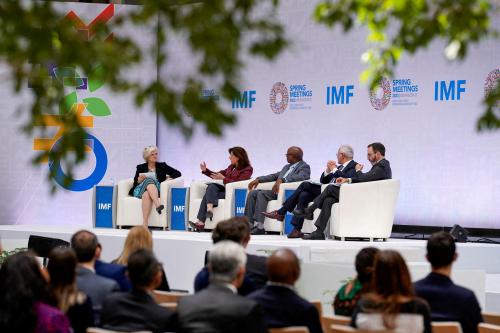The development community issued a collective sigh of relief last week when the U.S. Senate, after a seven-month delay, finally confirmed a new Administrator of the United States Agency for International Development (USAID). In addition to dealing with the many global development issues, Gayle Smith also has the task of making good on the Obama administration’s commitment to make USAID a preeminent 21st century development agency.
While a year might seem a short time for anyone to make a difference in a new government position, Gayle Smith assuming the lead in USAID should be seen more as the capstone of a seven-year tenure guiding U.S. global development policy. She led the interagency process that produced the 2010 Presidential Policy Determination on Development (PDD), and has been involved in every administration development policy initiative since, including major reforms inside USAID.
The five items below are suggestions on how Smith can institutionalize and take to the next level reforms and initiatives that have been part of the development agenda of which she has been a principal architect.
Accountability: Transparency and evaluation
The PPD lays out key elements for making our assistance programs more accountable, including “greater transparency” and “more substantial investment of resources in monitoring and evaluation.”
USAID staff have designed a well thought out Cost Program Management Plan to advance the public availability of its data and to fulfill the U.S. commitment to the International Assistance Transparency Initiative (IATI). What this plan needs is a little boost from the new administrator, her explicit endorsement and energy, and maybe the freeing-up of more resources so phases two and three to get more and better USAID data into the IATI registry can be completed by the end of 2016 rather than slipping over into the next administration. In addition, the fourth and final phase of the plan needs to be approved so data transparency is integrated into the planned Development Information Solution (DIS), which will provide a comprehensive integration of program and financial information.
Meanwhile, in January 2011 USAID adopted an evaluation policy that was praised by the American Evaluation Association as a model for other government agencies. In FY 2014, the agency completed 224 evaluations. The new administrator could provide leadership in several areas that would raise the quality and use of USAID’s evaluations. She should weigh in on the sometimes theological debate over what type of evaluation works best by being clear that there is no single, all-purpose type of evaluation. Evaluations need to fit the context and question to be addressed, from most significant change (focusing solely on the most significant change generated by a project), to performance evaluation, to impact evaluation.
Second, evaluation is an expertise that is not quickly acquired. Some 2,000 USAID staff have been trained, but mainly through short-term courses. The training needs to be broadened to all staff and deepened in content. This will contribute to a cultural change whereby USAID staff learn not just how to conduct evaluations, but how to value and use the findings.
Third, evaluations need to be translated into learning. The E3 Bureau (Bureau for Economic Growth, Education and Environment) has set the model of analyzing and incorporating evaluation findings into its policies and programs, and a few missions have bought evaluations into their program cycle. This needs to be done throughout the agency. Further, USAID should use its convening power to share its findings with other U.S. government agencies, other donors, and the broader development community.
Innovation and flexibility
Current USAID processes are considered rigid and time-consuming. This is not uncommon to large institutions, but in recent years the agency has been seeking more innovative, flexible instruments. The USAID Global Development Lab is experimenting with what is alternatively referred to as the Development Innovation Accelerator (DIA) or Broad Agency Announcement (BAA), whereby it invites ideas on a specific development problem and then selects the authors of the best, most relevant, to join USAID staff in co-creating solutions—something the corporate sector has been calling for—to be involved at the beginning of problem-solving. Similarly, the Policy, Planning, and Learning Bureau is in the midst of redesigning the program cycle to introduce adaptive management, allowing for greater collaboration and real-time response to new information and evolving local circumstances. Adaptive management would allow for more customized approaches and learning based on local context.
Again, the PPD calls for “innovation.” As with accountability, an expression of interest and support from the new administrator, and an articulation of the need to inculcate innovation into the USAID culture, could move these endeavors from tentative experiment to practice.
The New Deal for Fragile States
Gayle Smith has been immersed in guiding U.S. policy in unstable, fragile states. She knows the territory well and cares. The U.S. has been an active participant and leader in the New Deal for Fragile States. The New Deal framework is a thoughtful, comprehensive structure for moving fragile states to stability, but recent analyses indicate that neither members of the G7+ countries nor donors are following the explicit steps. They are not dealing with national and local politics, which are the essential levers through which to bring stability to a country, and are not adequately including civil society. Maybe the New Deal structures are too complicated for a country that has minimal governance. Certainly, there has been insufficient senior-level leadership from donors and buy-in from G7+ leaders and stakeholders. With her deep knowledge of the dynamics in fragile states, Smith could bring sorely needed U.S. leadership to this arena.
Policy and budget
The PPD calls for “robust policy, budget, planning, and evaluation capabilities.” USAID moved quickly on these objectives, not just in restoring USAID former capabilities in evaluation, but also in policy and budget through the resurrection of the planning and policy function (Policy, Planning, and Learning Bureau, or PPL) and the budget function (Office of Bureau and Resource Management, or BRM). PPL has reestablished USAID’s former policy function, but USAID’s budget authority has only been partially restored.
Gayle Smith needs to take the next obvious step. Budget is policy. The integration of policy and budget is an essential foundation of evidence-based policymaking. The two need to be joined so these functions can support each other rather than operating in isolated cones. Budget deliberations are not just about numbers; policies get set by budget decisions, so policy and budget need to be integrated so budget decisions are informed by strategy and policy knowledge.
I go back to the model of the late 1970s when Alex Shakow was head of the Policy, Planning, and Coordination Bureau (PPC), which encompassed both policy and budget. Here you had in one senior official someone who was knowledgeable about policy and budget and understood how the two interact. He was the go-to-person the agency sent to Capitol Hill. He could deal with the range of issues that always unexpectedly arise during congressional committee hearings and markups. He could effectively deal with the State Department and interagency meetings on a broad sweep of policy and program matters. He could represent the U.S. globally, such as at the Development Assistance Committee (DAC) and other international development meetings.
With the expansion of the development agenda and frequency of interagency and international meetings, such a person is in even greater need today. USAID needs three or four senior officials—administrator, deputy administrator, associate administrator, and the head of a joined-up policy/budget function —to cover the demand domestically and internationally for senior USAID leadership with a deep knowledge of the broad scope of USAID programs.
Food aid reform
The arguments for the need to reform U.S. food assistance programs are incontrovertible and have been hashed hundreds of times, so no need to repeat them here. But it is clearly in the interests of the tens of millions of people globally who each year face hunger and starvation for the U.S. to maximize the use of its resources by moving its food aid from an antiquated 1950s model to current market realities. There is leadership for this on the Hill in the Food for Peace Reform Act of 2015, introduced by Senators Bob Corker and Chris Coons. Gayle Smith could help build the momentum for this bill and contribute to an important Obama legacy, whether enactment happens in 2016 or under a new administration and Congress in 2017.
Gayle knows better than anyone the Obama development agenda. These ideas are humbly presented as an outside observer’s suggestions of how to solidify key administration aid effectiveness initiatives.



Commentary
Gayle Smith’s agenda for USAID can take US development efforts to the next level
December 10, 2015